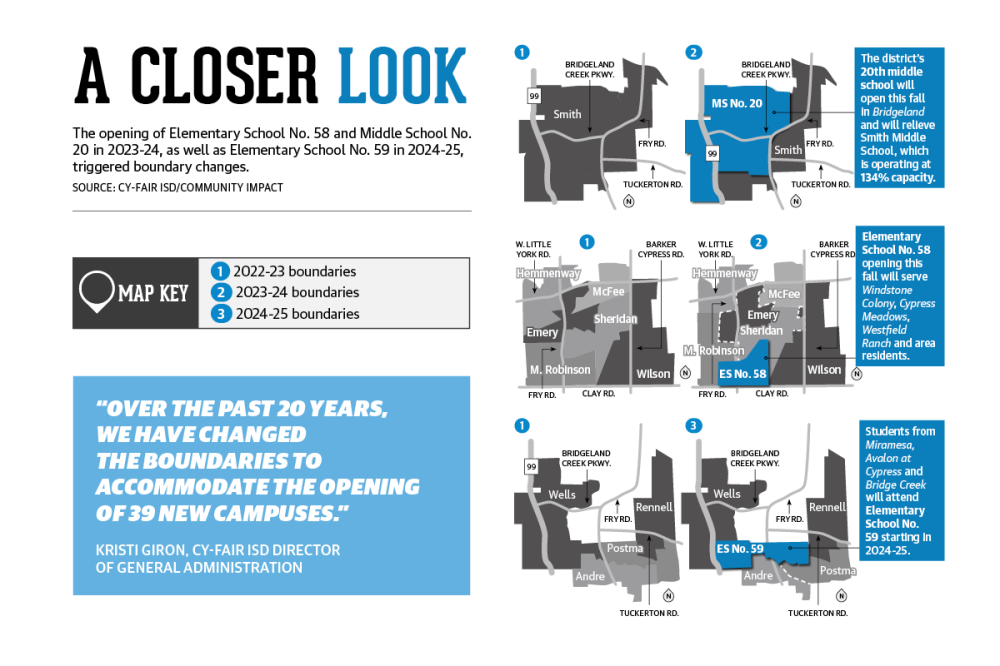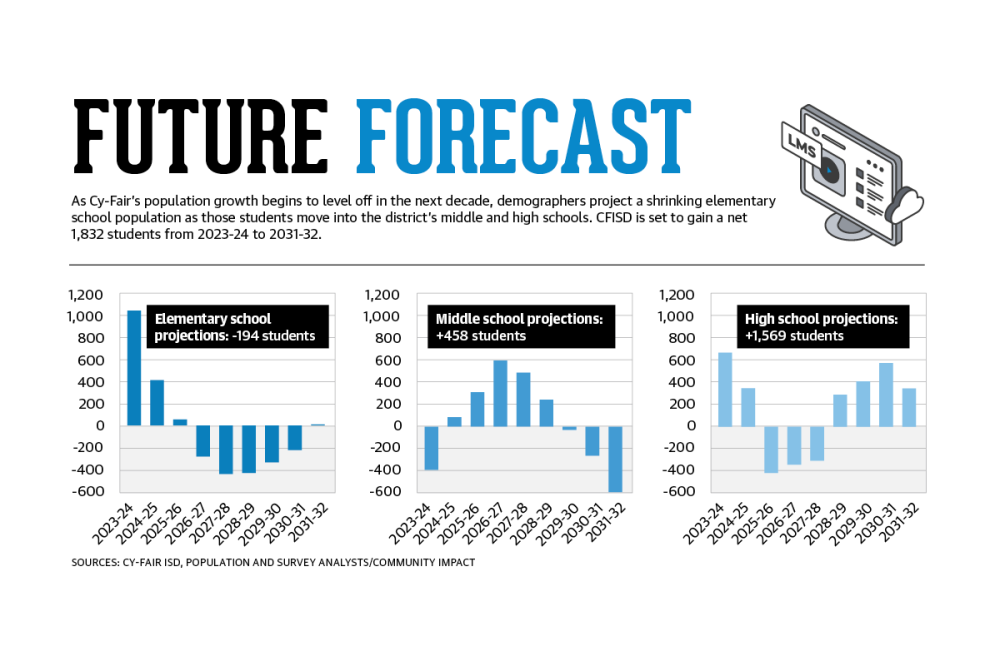Dozens of other attendance boundaries were also altered to relieve overcrowded schools, better utilize campuses operating under capacity and better align feeder patterns, district officials said.
“I know that it’s not easy. There are certainly a million and one different ways that you could possibly accomplish this,” Chief of Staff Teresa Hull said Dec. 8. “It’s unfortunate that I do think that this is a situation we’re going to find ourselves in over the next few years as the district completes its build-out, but we still have to address growth in different areas and we have to balance some of those enrollments.”
A committee of 18 district officials representing curriculum, athletics, transportation and other departments developed the recommendation.
The agenda item was discussed for five consecutive meetings starting Nov. 14, and slight adjustments were proposed during that time that met the requests of both residents and board members. Board members listened to hours of public comment at meetings and reviewed community feedback submitted online. Leslie Francis, assistant superintendent for communication and community relations, said over 5,500 forms were submitted between Nov. 15-Jan. 12.
Many parents were not pleased with the proposed boundary changes. Residents of Bridge Creek, one of the newest neighborhoods in Cypress, showed up in force to advocate against the initial plan to rezone their students to Cypress Springs High School. The final boundary changes ultimately kept Bridge Creek zoned to Cypress Ranch High School.
“We all have recently uprooted our families and moved here from all over the country. Then we were notified that our children would be uprooted again from both their elementary and high schools and not be continuing on with their friends and classmates,” Bridge Creek resident Bandita Sai said.

The need for rezoning
Several factors go into the attendance boundary proposal process, including enrollment projections, school capacities, feeder patterns, community input and keeping changes to a minimum. Geographical factors such as neighborhoods are considered as well, according to Director of General Administration Kristi Giron.
As of enrollment data captured in late October, several campuses are already overcapacity for the 2022-23 school year with Smith Middle School at 134% capacity and Rennell and M. Robinson elementary schools at 118%. Meanwhile, other campuses are under capacity as low as 66% utilization at Metcalf Elementary School.
In addition to populating new schools, redrawing the boundaries will help balance enrollment at dozens of campuses across the district, CFISD officials said.
Giron said Cypress Ranch High School is understaffed by five teachers and already has 24 “floating” teachers who do not have a home base due to a lack of space. With a capacity for 3,219 students, the campus had 3,626 enrolled as of the fall semester.
Boundary changes will relieve Cypress Ranch and Bridgeland high schools and send more students to underused Cypress Falls and Langham Creek high schools.
Sarah Harty, CFISD assistant superintendent for school leadership, said seeing choirs singing in hallways and art teachers doing their work on loading docks is commonplace at overcapacity schools. On the other hand, underused campuses have their own challenges.
“There are huge disadvantages to being underutilized in a building—when you don’t have enough students, many programs can suffer,” she said. “You run the risk of not being able to offer courses ... particularly with your dual-credit courses, your Advanced Placement courses, those language courses, those higher-level courses.”
Giron said the district’s growth over the past 20 years has brought the need for 39 new campuses, so rezoning has occurred several times over that period. However, the opening of Elementary School No. 58 and Middle School No. 20 in 2023-24 and Elementary School No. 59 in 2024-25 will complete the new schools included in the district’s $1.76 billion bond program approved in 2019.
Superintendent Mark Henry said a 13th high school was not included in the bond and likely will not open until the 2030s based on current projections. At this time, the construction of a new high school would cost an estimated $275 million, and rezoning helps postpone the need for another bond program, officials said.
“Please know that we don’t take these recommendations lightly,” Hull said. “We understand the complexity of this. We understand the emotion of the parents when faced with having to change schools. ... It’s difficult when you’re a part of a district like ours that not only continues to grow, but we are a large district where we’re seeing changes in our current campuses.”

Community input
Residents from a few neighborhoods—including Bridge Creek, Towne Lake, Hidden Arbor and Stone Gate—made up most of the feedback shared at board meetings over the past two months.
Parent concerns included the potential of neighborhoods being split up, being moved from schools they were told their children would attend when they purchased their homes and increased travel times. Others expressed concerns for students’ mental health when faced with the uncertainty of a new school—especially after having recently endured the pandemic and other stressful situations.
Sophia Payrovi, an eighth-grade Spillane Middle School student, spoke at the Jan. 9 board work session about her desire to stay zoned to Cypress Ranch High School—the campus she has been looking forward to attending for years. She said the COVID-19 pandemic disrupted her fifth-grade year, and she never got to say goodbye to many of her friends zoned to Arnold Middle School.
“Then I was online all of sixth grade, and I got social anxiety because of it. So, basically, I had to re-enter seventh grade knowing almost nobody with social anxiety, and that is extremely difficult because middle school is hard enough as it is,” she said.
Trustees empathized with the emotions parents and students expressed throughout the past several meetings.
Trustee Debbie Blackshear acknowledged making boundary changes was her least favorite part of her job as a trustee due to the painful nature of the process. She also explained shifts in the district’s attendance boundaries are to be expected in a fast-growing district such as CFISD.
“I am so sorry for those of you that your Realtors told you that your child would attend a certain school. ... They can’t promise that,” Blackshear said.
Board President Tom Jackson shared his own experience his children went through in overcrowded CFISD schools.
“My son, the first week of his sophomore year, stood in his math class. There were no desks. ... And for [Cypress] Ranch and Bridgeland [high schools], they are significantly overcrowded. Something has to be done,” he said Jan. 9. “And the capacity ... is felt most keenly in the cafeteria. I remember my son having lunch at 10 in the morning. The cafeterias simply are not built large enough for the number of students when we have a population surge.”
A split decision
By the time of the vote Jan. 12, the board had narrowed its final decision to two options—approve the recommended boundary changes as proposed by district administration or pause the rezoning of Stone Gate residents from Cypress Ranch High School to Cypress Falls and decide that part of the plan next year.
Giron said this will be the third time this neighborhood has been rezoned since it was created in 1998-99, and it has only been zoned to Cypress Ranch since 2017-18.
This idea of a pause came about at the Jan. 9 meeting. Dozens of residents showed up to ask the board to keep them zoned to Cypress Ranch. Several residents said they believe Stone Gate is more established and does not have as many new families moving into the neighborhood as some other parts of the district. Others proposed a pause on the decision, noting economic uncertainty of the next year may influence the projected enrollment levels.
Trustees Blackshear, Jackson, Julie Hinaman and Gilbert Sarabia approved the administration’s recommendation, which did not include the pause. The board’s three newest members—Lucas Scanlon, Natalie Blasingame and Scott Henry—voted in opposition.
“We’ve heard it come up numerous times—we want to minimize disruption, but we also have financial responsibility to use our assets well, and so as a board ... we get the super fun job of making that hard decision,” Scanlon said. “One of the things that I want to make sure that I’m paying attention to is the weight that I provide to the voice of the community.”
Students affected by the boundary change entering fifth grade or eighth grade in 2023-24 can remain at their current campus if parents provide transportation. This option is also available for younger siblings attending the same campus in 2023-24.
At the high school level, boundary changes only impact incoming ninth graders. Affected students who will have an older sibling in 10th, 11th or 12th grade attending the affected high school can choose to transfer to their original high school instead.





